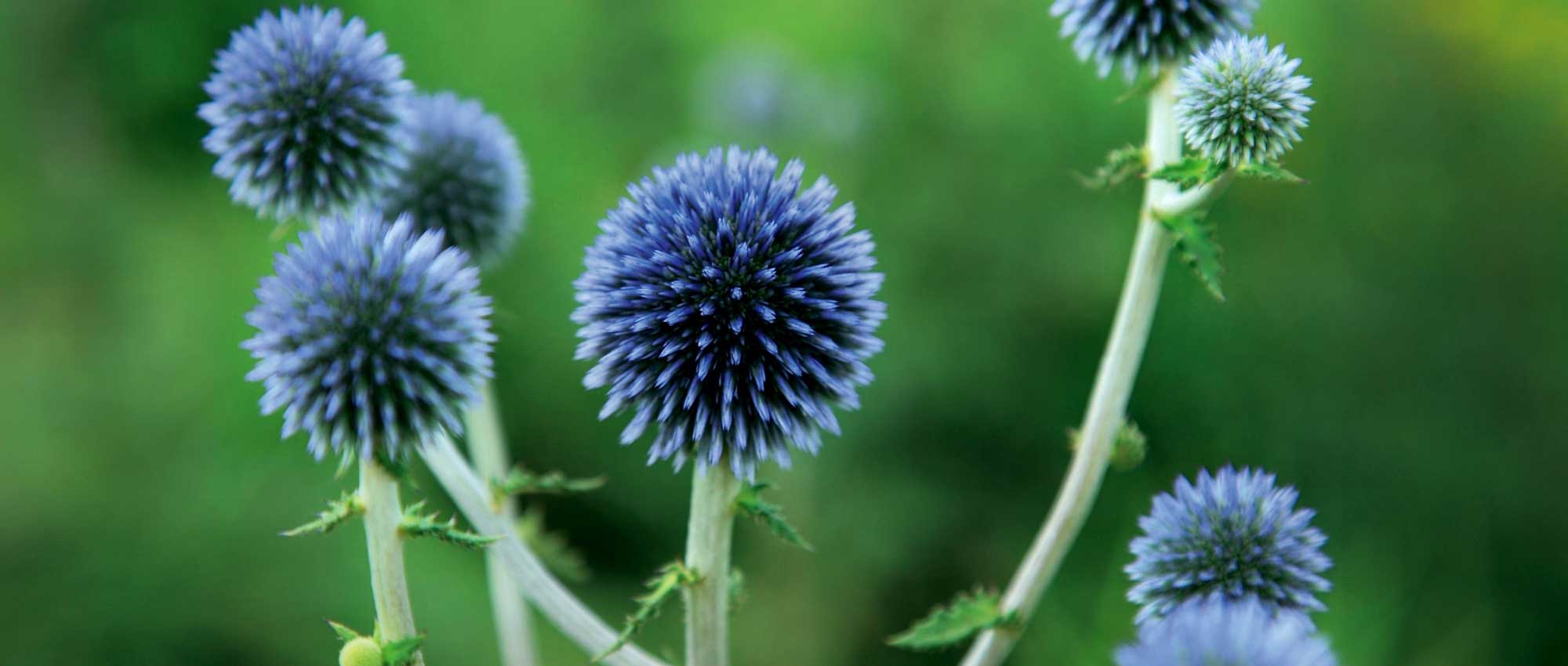
Echinops: planting, growing and care
Contents
Echinops in a nutshell
- Echinops bear superb spherical inflorescences in summer
- They take on unusual, metallic colours
- With its upright stems bearing silvery spheres, Echinops is a very architectural plant
- Easy to grow, Echinops require little maintenance, are not very susceptible to disease and tolerate drought
- Plant notable for its metallic colour and form, very architectural
- Flowering stems ideal for vases, for arranging bouquets
A Word from Our Expert
Echinops have thorny foliage and bear terminal inflorescences in summer, often metallic blue, somewhat silvery. Flowers form small blue spheres that seem made of little bristly points! Echinops have a modern, original look; they offer a beautiful blend of silvery grey and metallic blue, combined with a very graphic habit. Their flowering stems fit nicely into bouquets, whether used fresh or dried. Moreover, they are good melliferous plants: their flowers, rich in nectar, attract butterflies and bees.
Echinops are genera of ornamental thistles. The most common in cultivation are Echinops ritro, Echinops sphaerocephalus, and Echinops bannaticus. They declinate into different varieties, offering compact or taller sizes, and bearing flowers often blue–grey, but sometimes silvery white.
Echinops appreciate heat, sun and well-drained soils. They are easy-to-grow plants, hardy, undemanding and requiring little attention. They are rarely affected by diseases or pests, and tolerate drought fairly well. If they thrive in your garden, echinops will tend to self-seed and may naturalise.
Botany
Botanical data
- Latin name Echinops sp.
- Family Asteraceae
- Common name Blue globe, Globe thistle
- Flowering July to September
- Height often between 90 cm and 1.20 m
- Exposure full sun, sometimes partial shade
- Soil type ordinary, rather poor, well-draining
- Hardiness -20°C
Echinops are spiny plants, mostly perennial (annuals and biennials also occur), and very hardy. They bear spherical inflorescences atop erect stems. Native to Europe, central and eastern Asia, and tropical Africa, they include nearly 190 species. The most common in cultivation are Echinops ritro, sphaerocephalus and bannaticus. In the wild, echinops are mainly found in relatively arid habitats, notably on dry short grass meadows, rocky slopes, fallow land and uncultivated ground. This explains why echinops are undemanding about soil type, grow well in poor soils and tolerate drought fairly well. In France, three species occur naturally: Echinops ritro, Echinops sphaerocephalus and Echinops exaltatus.
Echinops belong to the family Asteraceae (plants formerly called “Compositae”, comprising nearly 33,000 species). This is the family of daisies, dandelions and oxeye daisies… but also of thistles and knapweeds, to which echinops are fairly close. Echinops are sometimes called “globe thistle”. All these plants have inflorescences in heads, bringing together a large number of tiny flowers. Unlike dandelions and daisies, which have flat heads (all flowers on the same horizontal plane), echinops bear spherical heads.
Echinops are reminiscent of eryngiums, Eryngium, by their blue–grey colours, silvery stems, graphic inflorescences and spiny aspect.
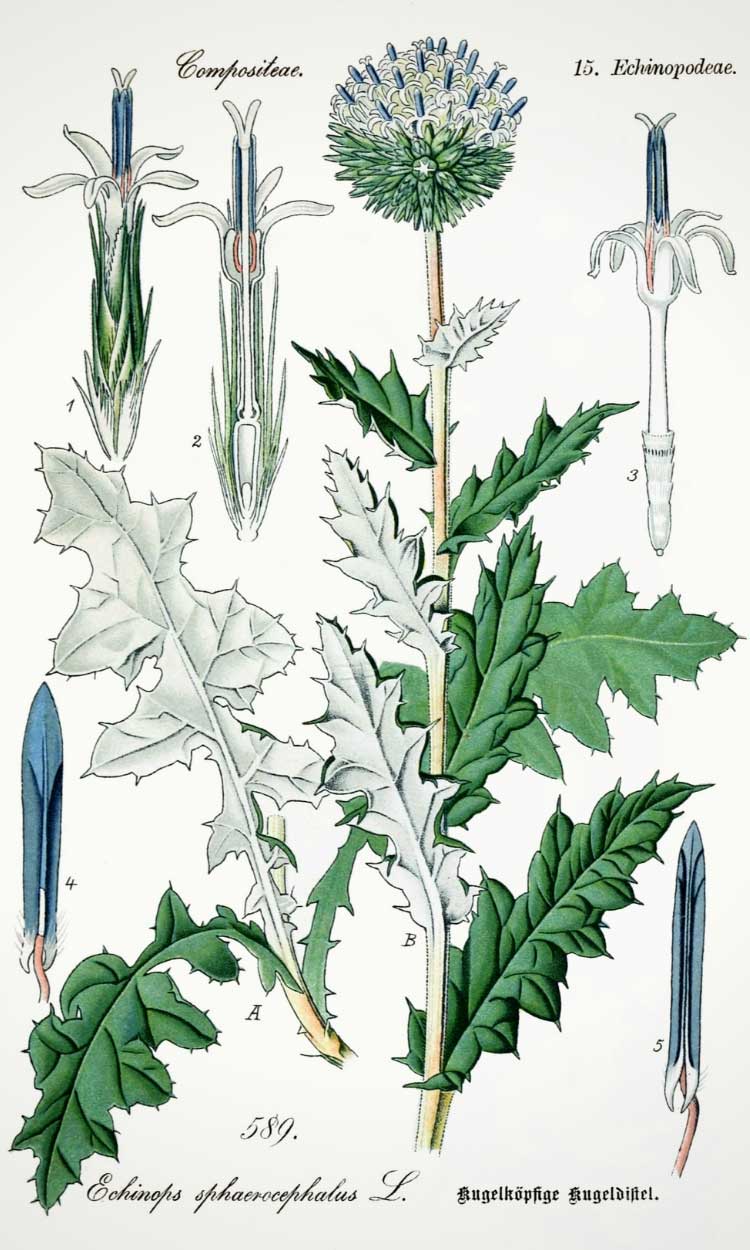
Echinops sphaerocephalus: Botanical illustration
Etymologically, the name Echinops comes from Greek meaning “hedgehog-like” (Echinos: hedgehog, and opsis: resembling), referring to the spherical inflorescences. Echinops is also the name of a small mammal, a genus of hedgehog. The plant bears several vernacular names: azurite, blue thistle, globe thistle, sea urchin, blue globe…
Echinops grow quickly and form clumps of erect, ramified stems topped by spherical inflorescences. They can measure between 60 cm and 1.50 m in height, but are often around one metre tall. Echinops giganteus is an exception: it can reach up to five metres! Among species common in cultivation, Echinops sphaerocephalus are slightly taller than others.
Echinops have a very open, airy habit that allows the eye to pass through the plant. They can create beautiful scenes with light when the spherical inflorescences catch sun rays, or by playing with frost in winter. Stems are sturdy and durable; if not cut back, they remain through winter.
Echinops flower in midsummer, from July through August or September. Flowering can sometimes be extended by pruning, removing faded flowers… which encourages the plant to rebloom.
The plant then bears, at stem tips, blue balls (spheres), hence the common name “blue globe”. These peculiar inflorescences resemble small sea urchins and also recall the flowering of Alliums. Flowers are all attached at the centre, on a receptacle, and radiate outwards. As they are thin and elongated they give the impression of a sphere bristling with little points. These inflorescences are very graphic, composing perfect, well-rounded spheres. They usually measure between 3 and 5 cm in diameter… but those of Echinops giganteus are much larger, between 10 and 20 cm in diameter! It is truly a giant echinops.
These inflorescences are therefore spherical heads, gathering numerous flowers attached to a common axis. The flowers are actually tiny, but each inflorescence contains a great many! Flowers are tubulate. Each is composed of five fused petals (five lobes) and five sepals. Inside the tube formed by the petals are five stamens (male sexual organs bearing pollen), blue-grey in colour, and a style. Flowers are thus hermaphrodite. They are also surrounded by spiny bracts.
Inflorescences are generally blue–grey in colour; a somewhat mysterious hue, at once deep and yet light, silvery, metallic. Unlike many other flowers, it is not a bright, clear colour. The variety Echinops ‘Arctic Glow’ stands out with white flowers. The spaces between flowers are always a little darker in shadow, adding contrast to the flowering and making each little “spike” stand out.
Floral stems of echinops are ideal for bouquets. They are very decorative in a vase, both during flowering and afterwards. You can cut the flowers and dry them by hanging heads down.
Echinops are melliferous: their flowers are much appreciated by insects. They attract bees and butterflies, which pollinate the flowers in exchange for nectar.

Flowering of Echinops sphaerocephalus (photo Drew Avery) and detail of an inflorescence of Echinops ritro (photo Patrick Ch. Apfeld)
Leaves of Echinops are spiny, elongated and attractively dissected. They are dentate, irregular, thick and leathery. Echinops graecus is distinguished by very fine foliage. Leaves bear small spines along the lamina margin, helping protect the plant from herbivores tempted to eat it. The prickliest by far seems to be Echinops spinosissimus; its lamina is very reduced but extremely spiny! Echinops leaves measure between 10 and 30 cm long. They are alternate, placed one after the other along the stems. Those at the base of stems are larger than those near the top. Lamina is attached directly to the stem, without petiole. It is even embracing, more or less surrounding the stem.
Foliage is deciduous, disappearing in winter with the cold.
Leaves are generally dark green (sometimes more or less grey) above and silvery beneath. Most often the upper surface is glabrous (without hairs), and the underside tomentose.

A leaf of Echinops bannaticus, foliage of Echinops sphaerocephalus (photo Lucy Downey) and underside of a leaf of Echinops exaltatus (photo Rolf Engstrand)
Stems bearing leaves and flowers have a lovely silvery colour. In Echinops ‘Star Frost’, inflorescences share that hue, giving the plant a relatively uniform appearance.
Echinops tend to self-seed… The plant can become somewhat invasive. It is quite simple to avoid unwanted seedlings by cutting stems after flowering.
Seeds are small elongated achenes topped by an egret of bristle, which allows them to be carried by the wind. As with many Asteraceae, fruits of echinops are wind-dispersed. This enables the plant to reach new territories. Infructescences (seedheads) resemble those of dandelions. They are very decorative, making Echinops interesting in the garden even in winter. They are also appreciated by birds.
Main varieties of Echinops
Most popular varieties
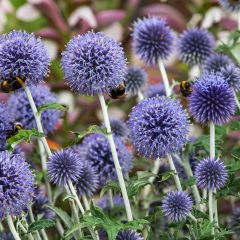
Echinops ritro
- Flowering time August to October
- Height at maturity 80 cm
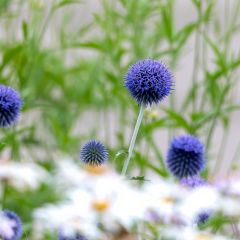
Echinops bannaticus Blue Globe
- Flowering time August, September
- Height at maturity 1,50 m

Echinops ritro Veitch’s Blue
- Flowering time August to October
- Height at maturity 80 cm
Our favourite varieties
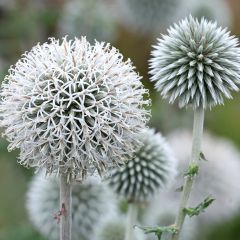
Echinops bannaticus Star Frost
- Flowering time August to October
- Height at maturity 1 m
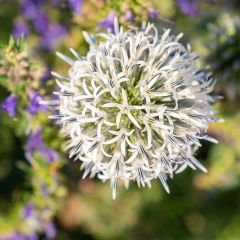
Echinops sphaerocephalum Arctic Glow
- Flowering time August, September
- Height at maturity 1,20 m
Discover other Echinops - Globe Thistle
View all →Available in 3 sizes
Available in 0 sizes
Available in 2 sizes
Available in 2 sizes
Available in 1 sizes
Available in 1 sizes
Available in 1 sizes
Available in 1 sizes
Available in 1 sizes
Planting Echinops
Where to plant?
Echinops are plants that like heat and need good light: plant them preferably in full sun, or possibly in partial shade.
Echinops are easy to grow, undemanding about nature of soil. They tolerate calcareous ground well. What matters above all is that substrate is well-draining, as they dislike standing water. If your ground tends to retain water, improve drainage (add gravel, coarse sand, etc.).
Echinops do very well in poor, low-fertility and relatively dry soils. It is not necessary to add compost or fertiliser. On the contrary, avoid planting them in very rich soils, because they would then produce large, tall stems that are more fragile and would need staking. The plant will look better in poor soil. Echinops also appreciate deep, loose substrates that allow their roots to penetrate well.
As echinops like stony, well-drained soils, you can perfectly plant them in a rockery, with plants that tolerate drought and enjoy full sun. They are also perfect in borders, alongside other perennials… or at back of a bed, for the tallest varieties!
If site suits it, echinops will tend to self-seed generously! It can even naturalise.
When to plant?
You can plant them in spring (April–May) or in autumn (September–October). Avoid periods of frost or extreme heat.
How to plant?
We recommend planting echinops in groups rather than singly; or else scatter several plants within the same bed, alongside summer-flowering perennials. Allow about 50 cm spacing, although this also depends on chosen variety.
- Dig a planting hole. It is not necessary to add compost, but you can improve drainage by adding gravel or coarse sand, or by planting on a mound.
- Remove your echinops from its pot and plant it.
- Replace soil around it, and firm gently.
- Water generously.
Continue to water until the plant is well established.
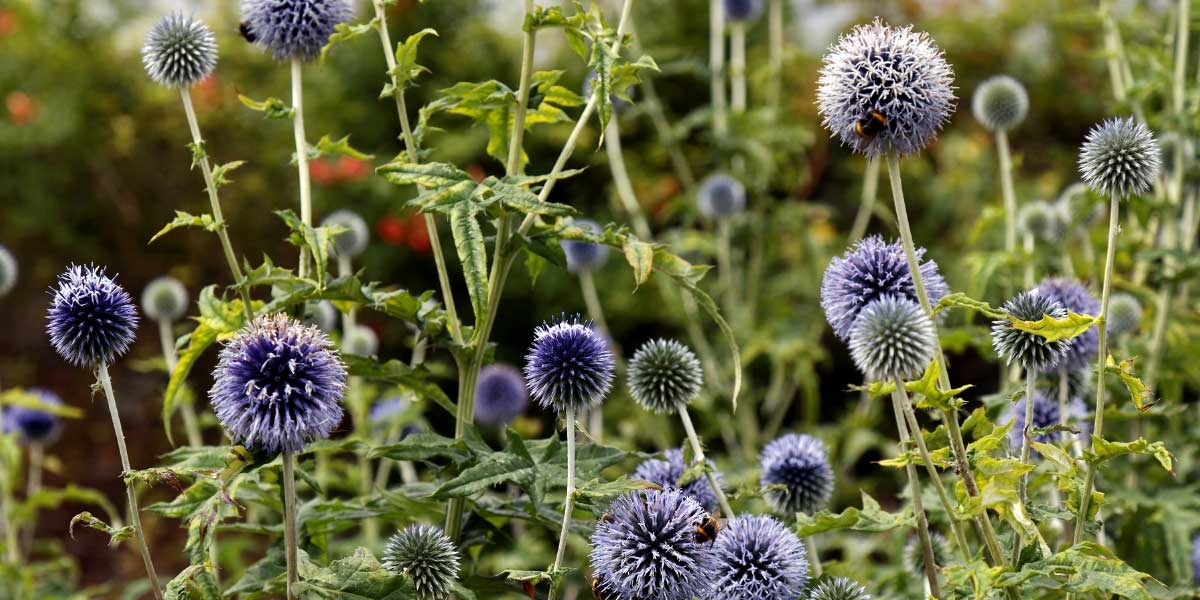
Echinops ritro (photo Acabashi)
Care
Echinops do not need much maintenance. Except during periods of drought, they do not really need watering. In any case, better avoid excess moisture.
Feel free to cut the flower stems to make bouquets! They last a long time in a vase. You can dry them by hanging them upside down, flowers facing down. Ideally place them in a dark, warm, dry and well-ventilated room.
You can either leave the stems in place over winter, as they remain decorative even after flowering; or cut the plant back in autumn. This will prevent it from self-seeding, because when it thrives in a spot it can become somewhat invasive.
Cutting off flowers when faded can allow the plant to flower again! Some varieties of Echinops are perpetual and can produce a new flowering in autumn.
If exposed to wind, Echinops may require staking to help keep its stems upright, particularly in taller varieties.
As Echinops favours poor soils, there is no need to add fertiliser or compost. You can optionally lay a layer of mulch around it, as this will limit weed growth and prevent soil from drying out too quickly.
We suggest renewing your young plants every three to four years, as they become less vigorous over time.
Echinops is rarely affected by diseases or pests. It may occasionally be attacked by aphids. It also dislikes excess moisture, which can cause it to rot.
Propagation: sowing, division, propagation by cuttings
Echinops can be propagated by sowing, division of clumps or propagation by cuttings of roots. You can also lift spontaneous seedlings and transplant them. Propagating echinops will allow you to renew your young plants, which may become exhausted over years.
Sowing
You can sow echinops in spring, around April, from seeds you have collected or bought. Sowing can be done in open ground (after last frosts), or in pots.
If you wish to sow directly in ground :
- Choose a sunny spot on free-draining soil. If necessary, add some coarse sand to improve water infiltration.
- Prepare seedbed, breaking up clods, remove large stones and weed roots. Level ground to obtain a flat, even surface.
- Scatter seeds on surface and cover very lightly.
- Water with a fine spray.
Continue to water over following weeks.
You can also start them in pots. In that case, prepare pots with good seed compost, then place seeds and cover with a very fine layer of substrate: they need a little light to germinate. Water with a fine spray. You can plant in open ground as soon as risk of frost has passed.
Division of clumps
Division of clumps is a good technique to regenerate young plants. It is carried out in early spring, or in autumn. We recommend doing it every three to four years.
- Choose a clump large enough, several years old
- Lift it gently, digging wide enough not to damage roots
- Separate into several pieces
- Replant each piece in a new position after preparing soil
- Water
Propagation by cuttings of roots
You can also multiply echinops by propagation by cuttings of roots, in winter or spring.
- Prepare a pot with compost mixed with sand.
- Choose a well-developed clump and lift it carefully, without damaging roots.
- If necessary, remove excess soil to make roots clearly visible.
- Choose a lateral root, fairly thick, healthy and well formed
- Cut it near base of plant to obtain a piece 5 to 10 cm long. Use a sharp, disinfected knife and make a clean cut.
- Replant original clump in ground and water.
- Then place root cutting in pot, under a few centimetres of substrate, laying it horizontally.
- Cover with potting compost
- Water.
- Place pot under cover, in frost-free conditions, in a bright spot.
Water regularly so substrate stays moist (without excess moisture) until plant establishes. Should take two to three months to develop.
→ Learn more about propagation by cuttings of Echinops in our tutorial.
Companion planting in the garden
When pairing Echinops, choose other plants that also thrive in full sun and well-drained soil.
You can include Echinops in a rock garden, with rock geraniums, sedums, lavender, achilleas, Eryngium, santolinas… For example, create a raised bed, place some large stones and, between them, plants that tolerate drought. You can also lay a mineral mulch around your plants (gravel, pumice…). You will obtain a garden that requires very little maintenance.
Don’t hesitate to pair Echinops with other plants in grey or silvery tones. Enjoy the wooly, very soft foliage of Stachys byzantina… but also the silvery leaves of santolinas, Helychrisum italicum, Senecio cineraria, Cerastium tomentosum, Convolvulus cneorum, wormwoods (Artemisia schmidtiana or ‘Powis Castle’), or centaury Centaurea pulcherrima… Also enjoy the striking foliage of Cynara cardunculus (cardoon, ornamental artichoke)! For small touches of colour, opt for rose campion, Lychnis coronaria.
Conversely, you can contrast the cool tone of Echinops with warm colours. Daylilies, rudbeckias and echinaceas, achilleas with yellow or red flowers (‘Terracotta’ or ‘Paprika’), etc., will warm the border and create a superb contrast. Echinops are perfect alongside larger, brightly coloured flowers. You can compose a superb summer border or a very colourful mixed border! Echinops provide a contrast of form and an airy lightness that highlights brighter flowers and broader foliage.
Because they have a light, airy, wild aspect, Echinops can easily be integrated into naturalistic gardens. Plant them alongside superb verbena hastata (Verbena hastata), burnets, agastaches, knautias… Moreover, Echinops are good melliferous plants. Take the opportunity to create a garden favourable to biodiversity. You can also include Nigella damascena with its superb, very delicate blue flowers.
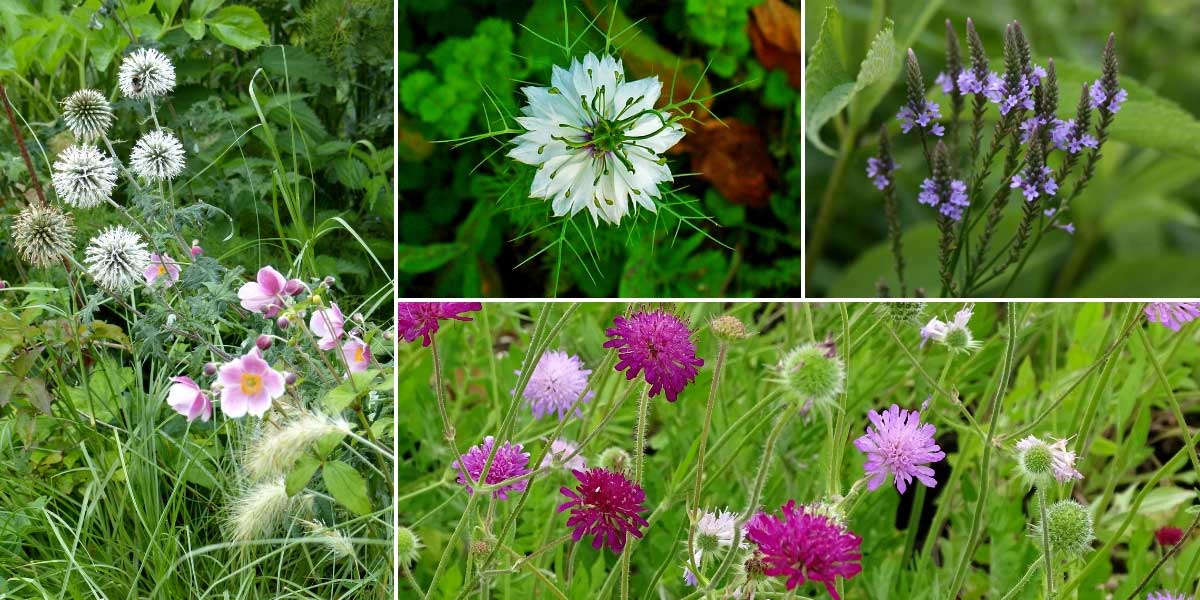
You can include Echinops in a very natural, wild-style garden. Echinops ‘Arctic Glow’ with Anemone ‘September Charm’ and Pennisetum villosum / Nigella damascena (photo H. Zell) / Verbena hastata (photo Cody Hough) / Knautia macedonica ‘Melton Pastels’
With their very structured habit and their original, metallic colour, Echinops allow you to create a modern, graphic garden! Dare contrasts, unusual shades, black, purple, white, silver… Choose other very graphic plants, such as Eryngiums, ferns, bamboos, horsetails, Japanese maples, Ophiopogon and grasses.
Echinops can also be integrated into a romantic garden, with roses, astrantias, thalictrums, clematis, agastaches, perovskias… Not forgetting the delicate flowering of Japanese anemones.
You can also choose other very light-looking plants to accompany them: gaura, perovskia, knautia, nigella… Echinops are perfect when paired with ornamental grasses: pennisetum, miscanthus, calamagrostis, and above all, Stipa pennata! Discover also the small ovoid spikes of Lagurus ovatus! You will obtain a very light border, both natural and modern in style.
→ Discover other lovely ideas for pairing with Echinops in our advice sheet!
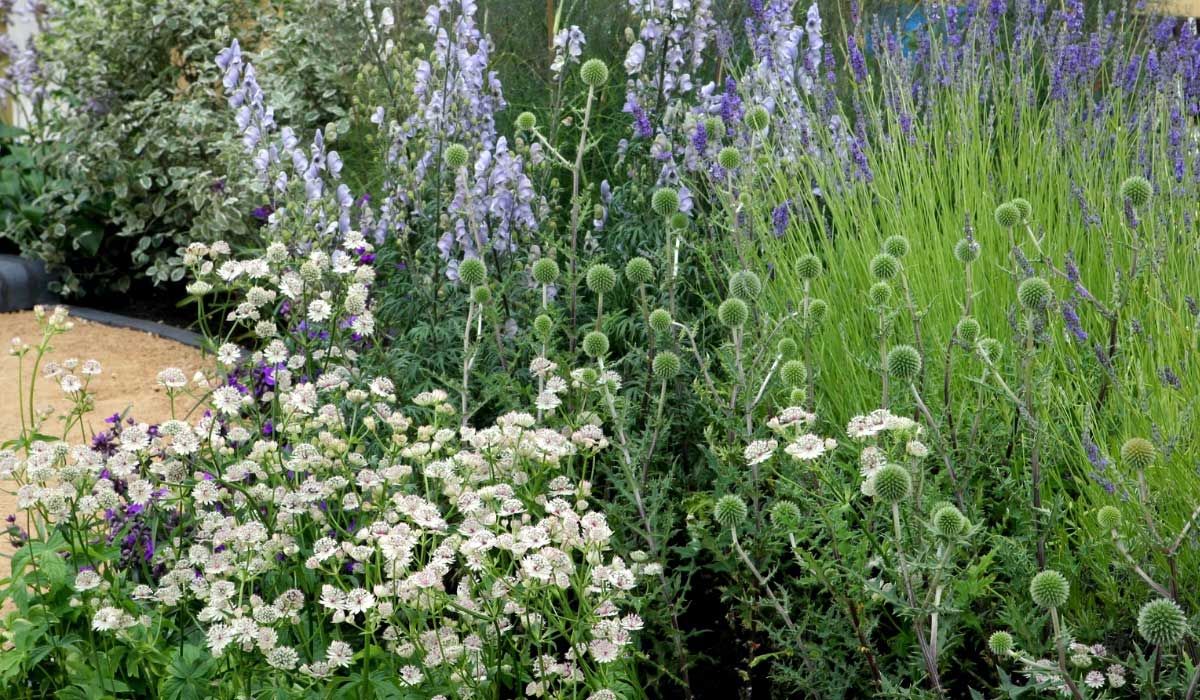
An idea for pairing Echinops sphaerocephalus, Astrantia major, Aconitum ‘Stainless Steel’ and Lavender (photo Nicole and Patrick Mioulane – MAP)
Useful resources
- Discover our range of Echinops!
- If you want to try sowing: our Echinops ritro seeds
- An article by Michael – How to botch planting your perennials in six lessons?
- An article by Ingrid – Flower beds: vary and mix shapes!
Frequently asked questions
-
My Echinops are self-seeding everywhere! How can I prevent this?
If you don't like it, dig up seedlings while still small. As a preventative measure, deadhead flower stems once faded. Mulching around the plant also limits spontaneous sowings.
-
Should I prune Echinops after flowering?
Pruning after flowering cleans clumps, prevents spontaneous sowing, but can also encourage new flowers – Echinops can be perpetual. However, upright stems and seedheads bearing seeds are sturdy enough to remain in place through winter, and are rather decorative when they do. They can continue to give structure to the border in winter.
- Subscribe!
- Contents
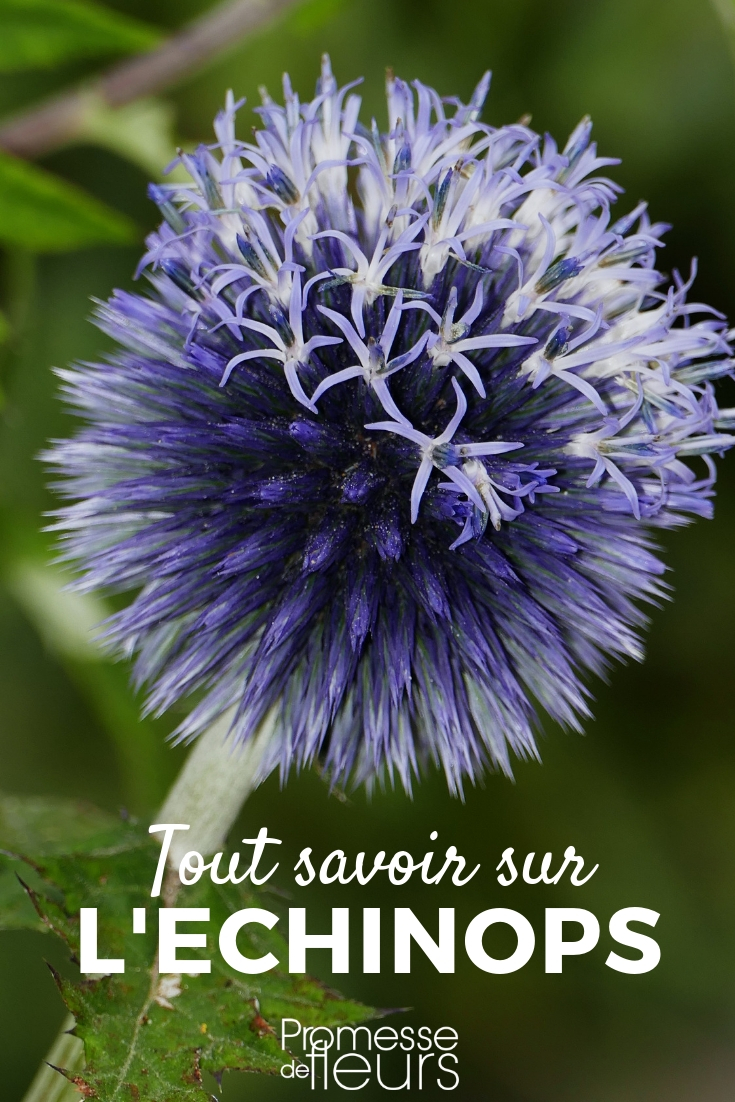
































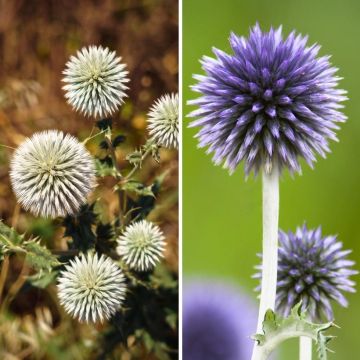
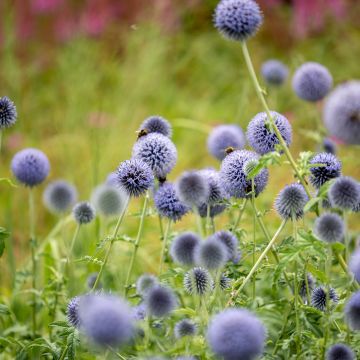
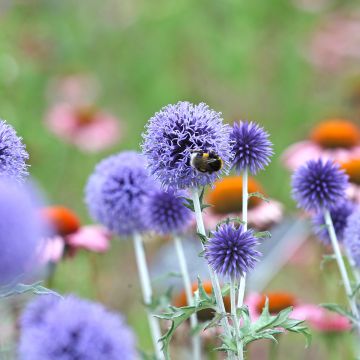

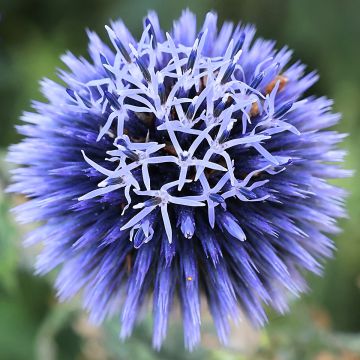
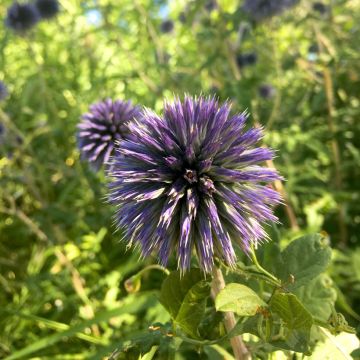
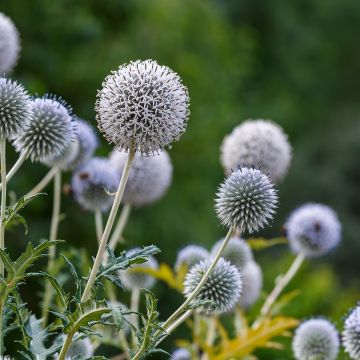

Comments